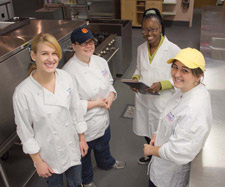food fight
Neil Caudle
 The Three Senioritas team: Audrey Boushell, Keri Lipscomb, Aubrey Coffee (faculty advisor), and Kathryn Davis.
The Three Senioritas team: Audrey Boushell, Keri Lipscomb, Aubrey Coffee (faculty advisor), and Kathryn Davis.
Two creations by two teams of students. Both have a shot at the prize. Their edge? Science.
JoAnna Gorcesky admits she’s a little bit nervous about the big shootout in San Antonio. “I have dreams about it,” she says. “Not the good kind.”
But Gorcesky, a senior in food science and human nutrition, says she’ll be ready, come March. She and teammates Mollye MacNaughton and Chad Carter already show a bit of Texas swagger as they prep their savory pastries in the research kitchen of Poole Hall.
In San Antonio, the team will cook against student teams from across the nation in a contest sponsored by the Research Chefs Association.
The stiffest competition may well come from another Clemson team, the Three Senioritas, whose dip duo aims at the same market: party food for people with a taste for Tex-Mex. At stake: $5,000 for the winning team.
“We have finalized our commercial product, and now we’re working on our speed and efficiency,” MacNaughton says. “We have to prep and cook the whole dish in an hour and a half.”
Both teams began with the same set of ground rules: each dish would be Tex-Mex, would include pork, would qualify for sale in the frozen-food aisle of a club store, and would retail for $7.99. The cost of the ingredients, including the package, could not exceed 25 percent of retail price.
And (this is the hard part) the frozen product, heated and served to the judges, would have to match the “gold standard,” the dish as the team would prepare it from scratch during the contest using fresh ingredients.
One food, two versions
Consider the label of any frozen, prepared food. Most of the mystifying ingredients listed there are present because freezing, shipping, storing, and reheating will, without help from modern chemistry, yield a flavorless, soggy mush. So a commercial product, with its stabilizers, emulsifiers, and flavor enhancers, is radically different from the version made at home.
Cheese sauce, a must for both teams, has trouble keeping itself together in a freezer. And the small amount of lard in the pastry shell for Texas triangles? That’s a no-no in the commercial version. So the food scientist adds, with precision, a touch of artificial lard flavoring, to give the crust a hint of richness. Smoked meat, grilled meat, lime juice, or almost any other flavor you can imagine has a chemical correlate, but you have to know the science to use it.
“You run experiments,” Chad Carter says. “You try each ingredient, measure it exactly, keep careful records, and analyze the results. It’s a long process of trial-and-error. This is real research.”
Beyond the kitchen
After some brainstorming, both teams settled on ideas for products, refined their recipes, and delved into an industrial-strength database of product information, food-consumption patterns, and sales trends for the food industry. Drawing on the research, each team developed a business model, defined a market niche, and developed marketing materials. They also calculated nutritional information and used a focus group of students, faculty, and staff to test various recipes. A student in packaging, Natalie Quin, designed packages for both teams’ products.
Carter, a chef who returned to college to retool for a new career in the food industry, says this kind of hands-on research is an ideal way to learn. “You take more ownership on a project like this,” he says. “People are passionate about what they’re doing.”
Aubrey Coffee, faculty advisor for both teams as part of Clemson’s Creative Inquiry program, says that today’s students are tuned in to the science of food. “When I started here in two thousand and five, I had twenty-five advisees,” Coffee says. “Now I have seventy-six. We tell people that we study food from the farm to the table. That’s what it’s all about.”
Aubrey Coffee is a senior lecturer and sensory coordinator in food science and nutrition in the College of Agriculture, Forestry, and Life Sciences. Creative Inquiry students earn course credit for conducting research.





